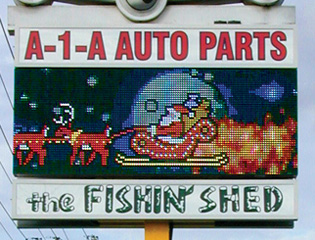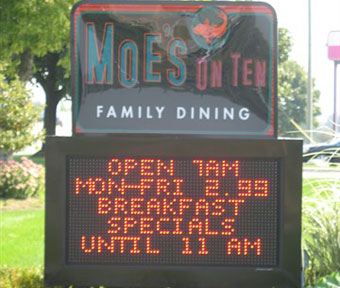
If an illuminated sign can’t be bright enough to be effectively seen at night, why bother using it at all?
This isn’t some philosophy question, but a very real challenge for the sign and graphics industry, especially when faced with arbitrary regulations.
This happened recently in California when the state’s powerful Energy Commission (CEC) proposed language that would require all signs to be no brighter than 160 nits at night. It also would have prevented electronic message centers from changing faster than every 20 seconds.
These sign lighting restrictions pose an existential threat to our industry: If illuminated signs are not allowed to “pop” and be bright enough to be effectively seen at night, will end user customers be as inclined to invest in them?
Fortunately, California Sign Association (CSA) representatives found out about this proposal and, working alongside ISA, contacted the consultants who were updating the state law. Together ISA and CSA were inserted as stakeholders into the process.
We showed up with a few key arguments:
- Science shows something different. ISA’s research into effective night-time brightness recommendations navigates the thin space between effective and obnoxious. These recommendations, based on research from a noted lighting expert, show that effective night-time brightness levels for EMCs are about twice what was proposed by the CEC. This guidance, Night-time Brightness Level Recommendations for On-Premise Electronic Message Centers, has been adopted by hundreds of communities and several state departments of transportation.
- The state was arguing with itself. The CEC’s proposed changes were in conflict with the state’s department of transportation, CALTRANS, which allows hold times of four seconds for digital signs, far less than the 20 seconds CEC wanted to impose on EMCs across the state.
- All stakeholders should have a say. The CEC’s proposal mirrored recommendations from International Dark Skies, a group which supports restricting outdoor night-time lighting. While I can’t say for sure that’s where the authors got them, it does certainly raise the question. If a stakeholder at one end of the spectrum can so heavily influence the state’s recommendations, the commission has to consider input from other affected stakeholders.
The end result of the ISA/CSA argument was a win in a few ways: We were able to turn back some of the most devastating requirements, including removal of the 20-second hold time and the sign lighting levels. Perhaps more importantly, ISA and CSA were inserted as stakeholders in the process and will be involved in discussions for the 2028 updates.
While ISA and affiliated associations like CSA are actively involved with state regulations, this one nearly slipped by, partially because this was an agency that typically does not regulate our industry.
Had CSA Executive Director Roy Flahive not heard about this issue, the rule could have been passed before we even knew about it. It would have meant trying to change a state regulation in three years—something that is harder to do once it has been enacted.
This is a reminder that we have to be vigilant and on top of issues like this. When you hear from a key contact or through the grapevine that unreasonable regulations are being proposed for signs, contact ISA as soon as possible. We are much more effective if we get involved on the front end.
Some states are more prone to heavily regulate businesses that operate within their borders. While all of us need to be on guard in those states—particularly with these lighting regulations that are making the rounds—we can’t go to sleep anywhere.
ISA and our partner the Sign Research Foundation have data and resources that make compelling arguments—like the economic value of signs and EMCs. But if we don’t know when to pull out our data, it may be too late to impact positive change.
Hear about proposed sign-related changes that are concerning? Contact me at [email protected].











